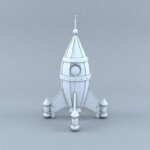1 Preface
The school’s original CNC lathe used the GSK981T system. Although it had played an important role in education in the past, the system was in disrepair, had frequent breakdowns, and served only one function. also cases of accidental loss of data from the system. Unable to meet educational needs. After extensive research, our school decided to modernize and transform the CNC lathe itself.
Huazhong CNC HNC-818D CNC system was selected for this CNC system upgrade. This CNC system is a bus CNC system developed by Wuhan Huazhong CNC Co., Ltd. It is based on NCUC industrial fieldbus technology with completely independent intellectual property rights. It adopts modular and open architecture and high reliability design, with high speed and speed. high-precision, multi-axis, multi-channel and cloud data features, with extremely high cost performance.[1]which can fully meet the teaching needs of our school in recent years, and has also accumulated some experience for the upgrade and transformation of other early CNC systems in our school.
2 Overall renovation plan
The overall design of the CK 6140 CNC lathe upgrade is as follows.
(1) The CNC system uses the Huazhong CNC HNC-818D CNC system to replace the GSK 981T to improve the system stability, processing precision and efficiency of machine tools, and reserve expansion functions for add more functions in the future.
(2) The main circuit and control loop of the electrical circuit are redesigned, but the original parts of the CNC machine tool are still used for the electrical cabinet and servo transformer to achieve the goal of reducing as much as possible modification costs while still meeting requirements.
(3) The power supply system replaces all original stepper drives and stepper motors with bus-type servo motors and servo motors with absolute position memory to improve power control accuracy, stability operating capacity and load capacity.
(4) The pin part retains the original frequency conversion pin. Forward rotation, reverse rotation and spindle stop, given speed and speed display are all achieved through the external IO unit.
(5) The IO input and output unit transforms the original system-integrated PLC into an external IO unit. Considering the transformation cost, the IO unit uses Huazhong HIO-1200-M1. Its bus is an IO unit with a total of 24 input bits and 16 output bits. It also has a DA interface (for frequency conversion pin) and a DA interface (for frequency conversion pin). spindle encoder interface.[2]fully capable of meeting upgrade and transformation needs.
(6) Except for the mechanical part, which needs to be redesigned due to changes in the size of the system and the control panel, the mechanical part still uses the original part of the machine tool. However, when selecting a servo motor, pay attention to the mechanical part. Installation interface with the aim of meeting the player’s requirements. Just be consistent with the machine tool.
(7) Machine tool setting and PLC programming According to the requirements of the control circuit and processing operation, reset the machine tool parameters and compile the machine tool PLC control program.
(8) The overall debugging of the machine tool optimizes the parameters of the machine tool, sets the soft limit, pitch compensation and clearance of the machine tool, etc., and comprehensively checks whether the various functions of the machine tool are normal and the accuracy is fully satisfied. the standards.
3. Specific modernizations of machine tools
(1) CNC system upgrade. The IPG of HNC-818D CNC system integrates all external interfaces and connects MCP machine tool control panel, UPS power supply, U disk, hand pulse generator, CF card, Ethernet, monitor and keyboard. , etc. External equipment, program expansion, data exchange and cabling are all very convenient and extremely cost-effective. A comparison of CNC device specifications before and after transformation is shown in Table 1.
Table 1 Comparison of CNC equipment specifications before and after transformation
Note: 1 inch = 0.0254 m.
(2) Electrical circuit upgrade The principle of the HNC-818D CNC high-voltage part is shown in Figure 1. The high-voltage part of the machine tool introduces 380V power into the electrical cabinet through the main switch QF0 of the electrical control cabinet of the machine tool, and the control cabinet achieves the purpose of opening the door and cutting off the power through the switch SQ0. QF3, QF4 and QF5 provide power supply, overload and short circuit protection to the hydraulic motor, cooling motor and tool holder motor respectively. QF2 powers the servo transformer TC1, which converts 380 V to 220 V, thereby providing power and operating power to the X and Z axis servo amplifiers; QF1 powers the spindle inverter;
Figure 1 Principle of HNC-818D CNC high current part
(3) The system bus of the control part of the HNC-818D machine tool requires a ring connection, in which the system and the machine tool control panel are only connected by the system bus. The working power of the machine tool control panel is entirely provided by the. System bus. There is no other independent power supply and an external manual impulse. The box is connected to the machine tool control panel, and the working power supply is also supplied by the bus. The bus goes from PORT0 of the IPC unit to XS6A of the MCP machine tool control panel, then from XS6B of the MCP to X2A of the IO unit, as shown in Figure 2, and finally to PORT3 of the IPC unit, forming a complete set. ring, allowing the CNC system to control and receive information from all components connected to the bus to form an organic whole.
Figure 2 HNC-818D system bus connection
(4) The servo of the machine tool power system is modified to use Huazhong CNC’s new generation HSV-160u full-digital AC servo motor, which has a high-speed industrial Ethernet bus interface to realize a High speed data exchange with CNC device. , and has a high-resolution absolute encoder interface, the resolution of position feedback reaches up to 23 bits. The servo motors all use Huazhong Huada motors. The motor encoders are all 23-bit absolute encoders and the rated speeds are all 1500 rpm. The rated torque of the X-axis servo motor is 5.4 N·m and the rated torque. of Z axis is 9.6Nm, all indicators are much better than the original configuration of the machine tool and can fully meet the needs of teaching.
(5) Transformation of the spindle part. Since the spindle drive retains the inverter, variable frequency motor and spindle encoder of the original machine tool, the design only needs to consider providing the corresponding operation instructions to the spindle drive. inverter, so this part is combined with the spindle part. transformation of the IO unit design.
(6) Renovation of IO input and output unit The IO unit uses Huazhong HIO-1200-M1, which is a bus type IO unit with a total of 24 inputs and 16 outputs. It also has a DA interface (for frequency). 0~10V conversion pin). and spindle encoder interface. For the CKA6140 CNC lathe, a HIO-1200-M1 board fully meets its control needs. If the I/O points are not enough when adding more functions in the future, you can purchase another one to increase the number of I/O via the NCUC bus. Figure 3 shows the I/O allocation address and its logic control circuit.
Figure 3 IO allocation address and its logic control circuit
When the machine tool is powered on for the first time, if there is no problem with the bus connection, check the system device configuration and the screen shown in Figure 4 will appear. For the HIO-1200-M1, it is 24 bits. 16-bit input and output. The input can be PNP or NPN at the same time, it can also be connected to the 0~10V output required by the inverter (can be selected through settings – 10~10V or 0~10V); it can also be connected to the spindle encoder. Its input and output can be divided into two parts through parameters, one part is the actual IO input and output, and the other part is occupied by the. analog output and spindle encoder rotation speed input, but the addresses of the two cannot overlap. The system can achieve this through parameter shifting.
Figure 4 Configuring system devices
(7) Spindle reduction ratio adjustment, X axis and Z axis. The spindle reduction ratio is 2:1, which corresponds to a single gear. The spindle encoder is directly connected to the spindle and speed. is continuously adjusted in the gear, taking into account the poor low-frequency torque performance of the motor, therefore the motor. The starting frequency is set to 30 Hz, the maximum frequency is set to 100 Hz, the spindle motor is a 4-pole variable frequency motor, and the motor slip is ignored, achieving a spindle speed of 450 to 1 500 rpm.
The X axis and Z axis are directly connected to the ball screw through couplings. The steps are 4mm and 6mm respectively. The servo motor encoders are all 23-bit absolute encoders. They just need to set the corresponding parameters 100004 and. 102004. Enter the corresponding step values 4000 and 6000 in the settings; enter 8388608 in parameters 100005 and 102005 and set the numerator and denominator of the position control pulse frequency division in the servo amplifier to 1:1.[3]。
(8) The machine tool parameters should be based on the use and processing range of the machine tool and set soft limits to prevent the machine tool from colliding with obstacles. Use a dial gauge or dial gauge to compile the corresponding processing program, operate the machine tool back and forth to test the pitch compensation, backlash, etc., and complete the adjustment of the machine- global tool.
4 Conclusion
Through this upgrade of CNC lathe, we can clearly feel the progress of Huazhong CNC system. The hardware connection has been considerably simplified. A bus connects all key equipment, making it much easier for users. The debugging screen is simple and orderly, which brings great convenience to users. Relevant experience has been accumulated during this upgrade, and after more than half a year of application, the upgrade has been proven to be successful.
Daguang focuses on providing solutions such as precision CNC machining services (3-axis, 4-axis, 5-axis machining), CNC milling, 3D printing and rapid prototyping services.






















